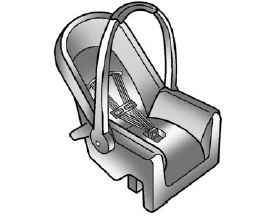Chevrolet Silverado: Starting and Operating / Starting the Engine
If the vehicle has a diesel engine, see the Duramax diesel supplement.
Caution
If you add electrical parts or accessories, you could change the way the engine operates. Any resulting damage would not be covered by the vehicle warranty. See Add-On Electrical Equipment.
Move the shift lever to P (Park) or N (Neutral). To restart the engine when the vehicle is already moving, use N (Neutral) only.
Caution
Do not try to shift to P (Park) if the vehicle is moving. If you do, you could damage the transmission. Shift to P (Park) only when the vehicle is stopped.
Starting Procedure
- For Key Access vehicles, turn the ignition key to Start. When the engine
starts, let go of the key. For Keyless Access vehicles, the RKE transmitter
must be in the vehicle. Press ENGINE START/STOP with the brake pedal applied.
When the engine begins cranking, let go of the button.
The driver may observe a minor, and temporary, brake pedal kickback when starting the vehicle. This is normal.
The idle speed will go down as the engine gets warm. Do not race the engine immediately after starting it. Operate the engine and transmission gently to allow the oil to warm up and lubricate all moving parts.
When the low fuel warning light is on and the FUEL LEVEL LOW message is displayed in the Driver Information Center (DIC), hold the ignition switch in the START position to continue engine cranking.
Caution
Cranking the engine for long periods of time, by returning the ignition to the START position immediately after cranking has ended, can overheat and damage the cranking motor, and drain the battery. Wait at least 15 seconds between each try, to let the cranking motor cool down.
- If the engine does not start after five to 10 seconds, especially in very cold weather (below −18 °C or 0 °F), it could be flooded with too much gasoline. Try pushing the accelerator pedal all the way to the floor and holding it there while holding the key in START or ENGINE START/STOP for up to a maximum of 15 seconds. Wait at least 15 seconds between each try, to allow the cranking motor to cool down. When the engine starts, let go of the key or button and accelerator. If the vehicle starts briefly but then stops again, do the same thing. This clears the extra gasoline from the engine. Do not race the engine immediately after starting it. Operate the engine and transmission gently until the oil warms up and lubricates all moving parts.
 Ignition Positions (Key Access)
Ignition Positions (Key Access)
0. Stopping the Engine/LOCK/OFF
1. ACC/ACCESSORY
2. ON/RUN
3. START
The ignition switch has four positions.
To shift out of P (Park), the ignition must be ON/RUN and the brake pedal must
be applied...
 Stop/Start System
Stop/Start System
If equipped, the Stop/Start system will shut off the engine to help conserve
fuel. It has components designed for the increased number of starts.
Warning
The automatic engine Stop/Start feature causes the engine to shut off while
the vehicle is still on...
Other information:
Chevrolet Silverado 2019-2025 Owners Manual: When It Is Time for New Tires
Factors, such as maintenance, temperatures, driving speeds, vehicle loading, and road conditions affect the wear rate of the tires. Treadwear indicators are one way to tell when it is time for new tires. Treadwear indicators appear when the tires have only 1...
Chevrolet Silverado 2019-2025 Owners Manual: Trailering App
Trailer Light App If equipped, the Trailer Lights App is on the Home Page of the infotainment display. Touch Start to cycle the trailer lamps on and off to determine if they are working. The test follows this sequence: The running lights turn on first and remain on throughout the sequence...
Categories
- Manuals Home
- 4th Generation Silverado Owners Manual
- 4th Generation Silverado Service Manual
- Programming Transmitters to the Vehicle
- Electric Parking Brake
- Engine Compartment Fuse Block
- New on site
- Most important about car
Child Restraint Systems

Rear-Facing Infant Restraint
A rear-facing child restraint provides restraint with the seating surface against the back of the infant.
